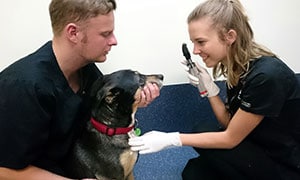Corneal Ulcers In Pets
Advice for when your cat or dog has an eye injury
Corneal ulcers are common eye injuries in dogs and cats. They are usually caused by trauma, a foreign body in the eye, infection, inability to form natural lubricating tears, or an abnormality in the eye. The cornea is the outer layer of your dog or cat’s eye. It has many layers and the seriousness of the injury depends on how many layers have been damaged. Injuries to the outermost layer can heal in a short time but deep ulcers can cause scarring or loss of vision and sometimes require surgery.
Brachycephalic breeds (short nosed) are prone to corneal ulcers due to the position and size of their eyes but this injury does occur in all breeds.
Symptoms
Squinting or sensitivity to light
- Pawing at the eye
- Watery or discharging eyes
- Red or inflamed eyes
- The eye doesn’t look normal including cloudiness or altered pupil size
- Pet appears in pain or discomfort
Emergency treatment before transport to a veterinarian
You can attempt flushing your pet’s eyes with sterile saline solution. However, it is best you seek veterinary help to ensure no further damage occurs, as further treatment is usually required.
If your pet has an eye injury, seek veterinary help. The longer this condition is left untreated the more serious the injury can become.
What to expect at the vet
Examination of the eye and cornea using a diagnostic stain
- A dry eye test
- Analysis of facial nerve function
- Treatment with eye drops for mild cases
- Analysis of culture taken from the eye in severe cases
- Referral to Specialists for surgery by a Veterinary Ophthalmologist in severe cases. This may involve the insertion of soft lenses or a corneal graft.
Prevention
The best way to prevent corneal ulceration is to recognise any changes to your pet’s eyes early and seek veterinary help if you notice anything new. The prognosis for pets with this condition is good as long as they are treated in a timely manner.
Pet’s Eyes and Medical Emergencies | Chihuahua diagnosed with Corneal Ulcer

 Squinting or sensitivity to light
Squinting or sensitivity to light Examination of the eye and cornea using a diagnostic stain
Examination of the eye and cornea using a diagnostic stain



